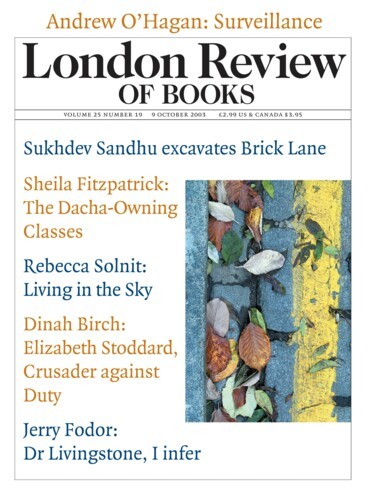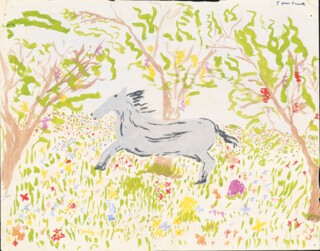In the more complete retrospectives, you may find a corner given over to drawings the artist did as a child. Typically, they will show ships, soldiers and, especially, horses. Pictures by someone who even at seven or eight was able to get things looking right bring back memories of the children in your class who were ‘good at art’. I was seven years and three months old when, in July 1944, my parents carefully dated the painting shown here. We who could do a better than average horse, tank, pretty woman or pony often stuck to just one of those. The talent shown by the ‘good at art’ was, like the interest which engendered it, commonly specific.
This is, or was, recognised by one kind of how-to-draw book. I have before me How to Draw Horses by John Skeaping, first published in 1941; this seventh impression is dated 1946. In the same series of twenty or so titles were How to Draw ‘Planes by Frank Wootton and Tanks and How to Draw Them by Terence Cuneo – both highly successful workers in long-lasting sub-genres. You can still order prints by Wootton of Spitfires chasing Messerschmitts, prints of steam locomotives by Cuneo and, indeed, prints of horses by Skeaping. But his particular how-to-draw book is, art historically, more complicated. Although he offers rules of thumb – he has diagrams, for example, of how a horse’s legs move in different gaits and shows how a sweeping mark with the broad side of a piece of chalk can at the same time represent the shape of a muscle and the gloss on a coat – the first seven pages of illustrations are given over to children’s drawings. There is one he did himself at eight-and-a-half of a cart horse, and a hunting scene made when he was ten. ‘By then I had seen many pictures by grown ups; I don’t think it is as good as the one of a horse and cart which was quite uninfluenced.’ He is keen to let children know that they are the best judges of their own work and warns them against knowledgable criticism from horsey people.
A sculptor as well as a draughtsman, Skeaping had been married to Barbara Hepworth, and the first three children’s drawings in his book – he compares one of them to an Etruscan bronze – are by five-year-olds, the triplets Hepworth had with her second husband, Ben Nicholson. Skeaping is a Modernist in his sympathies and wants to release his readers from the feeling that there is one proper way to show how things look. But his book is all about the pleasure to be had from drawing properly – not from being able to draw how you like, but from making realistic images of what you like – in this case horses.
Sir Alfred Munnings might have deplored Skeaping’s Modernist sympathies but not, I would guess, his way of drawing. Munnings used what could be learned from advanced 19th-century painting: he was in the literal sense a post-Impressionist for he borrowed brightness and briskness from their way of painting, if nothing from their attitude to subject-matter. The end of art for Munnings, as for the children who would have got most out of Skeaping, was to get the look of a horse, often in motion in bright weather, onto canvas. He was jolly good at it. There is a whole row of his horse pictures at the Royal Academy.* As with Cuneo’s railway trains or Wootton’s Spitfires or, indeed, Sargent’s society portraits, skill is made servant to subject. A Monet sequence of paintings of haystacks is not a tribute to haystacks or directed at farmers; Degas’s ballet girls are not flattered by his picture-making, and his pictures aren’t for ballet masters, either. A Munnings horse on the other hand has a lot of the stable about it – a lot of knowledge, no doubt, and a lot to attract others who know their hacks, hunters and ponies.
A reputation for having a knack for horses, girls, moonlight or what you will was good for sales. It also guaranteed that those pictures when shown together look less like interesting variations than near repeats. The sheer number of similar Pre-Raphaelite pieces Andrew Lloyd Webber has collected makes sense of the commentaries on Academy exhibitions which, often wearily, notice another of Mr X’s this or Sir A’s that. Just what distinguishes a repeat from a variation is easy to see but hard to describe. It does seem, though, that rich material doesn’t go with great art. There is much to enjoy in Desportes’s piles of game and leashes of hounds, but the frugal tradition of still life, from the suspended vegetables of Sánchez Cotán through Chardin’s kitchenware and Cézanne’s apples to Morandi’s dusty bottles, proves them to be distractions if painting, not the look of food, is what interests you.
A popular knack could be important when it came to making a living. It could also push a painter into becoming a bored specialist. If Atkinson Grimshaw hadn’t found that it was the moonlight scenes over water which sold best, he surely wouldn’t have stuck to them – there are 14 of them here. Sargent got bored with portraits, but had made enough money to free himself of the burden of painting them.
A buyer wants the typical, recognisable item. If you splashed out on an Alma-Tadema you wanted marble and a wine-dark sea (there’s one here with both); to have Tissot with horse-chestnut leaves against the light or shipboard detail – rigging, awnings, flags, deck fittings – was to have him at his most recognisable (there are several of those). Victorian painters and buyers accommodated themselves to each other in ways which could find out weaknesses in both parties.
To have a taste for paintings of a given subject is not, of course, a bad thing. It was interesting when the Tate had their big Stubbs show to see a lot of chaps there in twill trousers and hacking jackets stopping off on the way to the races: they looked ” at the pictures with a knowledge of horseflesh Stubbs would have found more to the point than any commentary of mine. But one subject does raise hackles, eyebrows, tempers and temperatures: women and, more particularly, girls.
The named varieties are as easy to bring to mind as marques of car: the Kate Greenaway moppet, the Gibson Girl, the Vargas pin-up; and if you want to go further back there is the Cranach minx and the Botticelli angel, the bouncing party girl Rowlandson had falling out of her clothes and Boucher’s powdered nymph who doesn’t wear any. They are more cheerful and healthier than the kind which loiter dimly at the Academy: Burne-Jones’s slim unsmiling girl-children, a bit undernourished with that dark look round the eyes which fits with the iconography of psychological damage; Rosetti’s seductresses, heavy-eyed, heavy-haired, full-lipped and big-chinned, overwhelmed by something unspeakable which is just possibly boredom; Tissot’s pansy-faced Edwardian girls doing the social round from picnic to drawing-room – lonely perhaps, or invalids. His model for many was his mistress Kathleen Newton, with whom he lived for five years in St John’s Wood. She died of consumption in 1882 and Tissot went home to France to paint a series of biblical paintings which were much admired in the Salon. Waterhouse’s adolescent girls are healthier than Burne-Jones’s, but they would have to be, judging by how often their pale bodies are seen by or in dank forest pools; sunless studio north light casts its chill over many imagined forests and rose gardens at the Academy. Girl-types, like tunes, can stick irritatingly in the mind, but I would have guessed the supply of new varieties had run out.
Not true. The work of John Currin at the Serpentine Gallery (until 2 November) shows one in the making. It starts with doll-like girls with huge breasts – there is a reference in one title to Dogpatch, but in Li’l Abner Daisy Mae is not so horribly inflated. In newer pictures this Viz-like grotesquerie is replaced by suggestions of girlish naughtiness. The participants look like perverse pixies; their smiling sharp-chinned faces ageless, or rather undateable: are they 14-year-olds pretending to be 40, or 40-year-olds playing at 14? A considerable number of Currin’s girls are already in public collections in the US. A new girl-type is getting a grip on the public imagination.
Send Letters To:
The Editor
London Review of Books,
28 Little Russell Street
London, WC1A 2HN
letters@lrb.co.uk
Please include name, address, and a telephone number.


